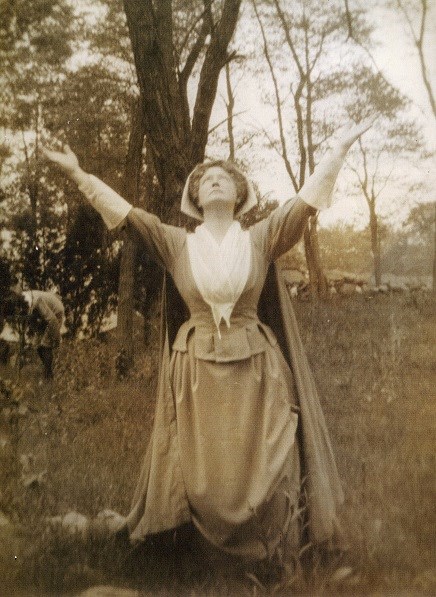Last updated: September 21, 2019
Article
Anne Hutchinson's Brief residence near St. Paul's Church

National Park Service photo
Anne Hutchinson, an uncommon woman who posed one of the earliest challenges to Puritan orthodoxy in 17th century Massachusetts, was killed by Native American Indians in 1643 at a location about one mile south of St. Paul’s Church.
She was born in England as Anne Marbury in 1591, the daughter of a minister and a midwife. Anne married Will Hutchinson, a successful silk merchant, in 1612, and they became followers of John Cotton, a dynamic Puritan clergyman who emphasized a Covenant of Grace, God’s free gift of salvation to unworthy people. Facing increasing harassment from the authorities of the Church of England, Rev. Cotton immigrated to the Puritan colony of Massachusetts Bay. In 1634, Anne, Will and 11 of their children followed their revered minister, crossing the Atlantic Ocean and settled in Boston.
In 1636, Anne began holding women’s meetings in her home to discuss the minister’s sermons. The meetings became popular forums, and soon drew men as well. Through these meetings and other activities, Anne emerged as a central figure in a serious religious dispute within the Puritan community centering over issues of God’s grace and salvation. Moving beyond Rev. Cotton’s theological views, Hutchinson adopted the belief that the elect could communicate directly with God and be assured of salvation, an immensely appealing vision for Puritans who were often in a state of tension over their chances of salvation. Her views also relegated the Puritan church and ordained ministers to less important roles. Additionally, her role as a leading religious and political dissenter was perceived as danger to the tradition order of gender roles.
In what became known as the Antinomian crisis, or the Free Grace Controversy, the religious appeals of Anne and other lay people and ministers in the Boston area were increasingly perceived as threats to the stability of the colony and its leaders, including Governor John Winthrop. Charged as a heretic, she was tried before the General Court in November 1637, and initially defended herself skillfully, matching Biblical references and wits with Winthrop and other accusers. But during the trial she claimed that God had communicated with her through “an immediate revelation” that he would curse the Puritans and their descendants if they harmed her. This claim led to a sentence of banishment. Following a house arrest and a second trial, Anne was ex-communicated from the Puritan church of Boston in March 1638.
Along with her family and a small number of followers, Anne moved to the religiously tolerant colony of Rhode Island, although the Massachusetts authorities continued to harass her. Will Hutchinson died in 1641, and Anne and her party of 16 people, including several of her children, moved on. In the early spring of 1642, they reached what was then the Dutch colony of New Netherland (today’s New York) settling near two friends, John Throckmorton and John Cornell, who were also religious exiles from Massachusetts Bay. The exact location of the Hutchinson homestead has never been determined, but it appears to have been on along a stream (since filled in) at what is today the New England Thruway (Interstate 95) at Baychester Avenue, in the northern Bronx, about one mile from this National Historic Site. She lived there for about 16 months.
The timing of her residence near here was problematic and ultimately fatal. The local Lenape Indians, who had lived in the vicinity for hundreds of years, were facing a genuine threat to their survival from European-introduced diseases and the land and commercial policies of the Dutch authorities who controlled New Netherland. While Anne probably received some form of permission from the colony’s officials to settle in the area, she had no such understanding with the Lenape. The Indians never recognized Dutch claims to the area and would have viewed even Anne’s small settlement as an intrusion and threat, especially at that juncture. The general conflict between the Indians and New Nethrland often called Keift’s War, and the Pavonia massacre of Lenape by Dutch militia in early 1643, created an especially tense situation during the period of Anne’s brief residence in the ea.
The Hutchinson party ignored warning by the local Lenape to abandon the settlement, perhaps secure in religious beliefs that God would protect them and recalling favorable relations with the Indians in Massachusetts and Rhode Island. In the summer of 1643, a Lenape war party attacked her home and killed all the settlers except for Anne’s young daughter Susanna, who was carried off to live with the Lenape; several years later she returned to New England.
Anne’s views and odyssey endured as symbols of religious liberty and the importance of individual conscience. More than 20 years later, the group of families who founded a new town initially called the area Hutchinsons. Early property boundaries referred to Hutchinson’s Creek and Hutchinson’s Meadow. In the 20th century the new State highway was named the Hutchinson River Parkway. In a broader historical context, Anne Hutchinson has endured as among the best known and most widely studied women in early America.
